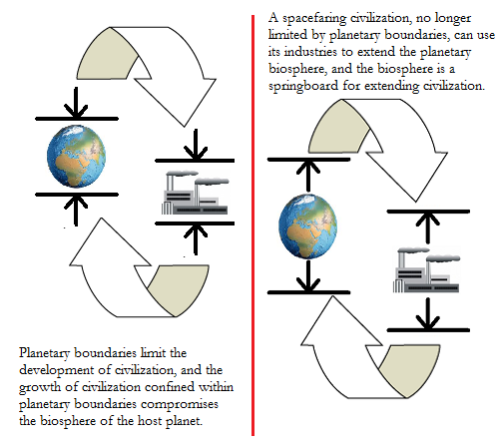Subscribe to the Grand Strategy Newsletter for regular updates on work in progress.
Discord Invitation
Post with 2 notes
Planetary Constraints 2

In Planetary Constraints 1 I reviewed some ideas I have been developing beginning in The Moral Imperative of Human Spaceflight and subsequently in Astrobiology is island biogeography writ large and Terrestrial Conflation. I can see the need to further explore these ideas, so I am going to try to make my way through several related ideas in a series of posts (if I can sustain the effort).
In my previous posts I mentioned the need to formulate the concepts and the vocabulary necessary to an exposition of the idea of the constraints to which civilization is subject as a consequence of emerging on the surface of the planet. This continues to be a concern of mine.
I think it is likely that when someone hears “planetary constraints” that they are likely to think of what in other contexts are called planetary boundaries, since a boundary is a kind of constraint. The Stockholm Resilience Centre at Stockholm University is responsible for the formulation of the planetary boundaries conception (sometimes abbreviated as PB); a section of their webpage explicitly addresses planetary boundaries, and staff of the Centre have published a couple of papers on the concept, the most recent paper being Planetary boundaries: Guiding human development on a changing planet.
The nine planetary boundaries identified by the Stockholm Resilience Centre include:
1. Climate change
2. Change in biosphere integrity (biodiversity loss and species extinction)
3. Stratospheric ozone depletion
4. Ocean acidification
5. Biogeochemical flows (phosphorus and nitrogen cycles)
6. Land-system change (for example deforestation)
7. Freshwater use
8. Atmospheric aerosol loading (microscopic particles in the atmosphere that affect climate and living organisms)
9. Introduction of novel entities (e.g. organic pollutants, radioactive materials, nanomaterials, and micro-plastics).
The formulation of these planetary boundaries is intended to provide a quantitative analysis of human impact on biosphere in order to drive policy decisions to limit human perturbations of Earth systems and so to secure, “a safe operating space for humanity on Earth.”
A comprehensive and quantitative analysis of the impact of human civilization on the biosphere is almost precisely the mirror image of the concept I am trying to formulate, which is the impact on human civilization of existing within a planetary biosphere.
The two concepts are closely linked, as I have repeatedly emphasized that when civilizations are confined to the surface of a planet, the growth of civilization compromises the biosphere from which it emerged, and the civilization cannot grow beyond limits (planetary boundaries) established by the biosphere. Civilization limits the biosphere, and the biosphere limits civilization. Even if a civilization is not ended by an existential threat that
results in extinction, a civilization may be permanently damaged by
conditions of planetary constraint, as a biosphere may be permanently damage by civilization.
However, if a civilization makes the transition to a demographically significant spacefaring civilization, then the limitations that civilization and biosphere place on each other are transformed into possibilities. The growth of a spacefaring civilization, not limited by the surface of a planet, extends the planetary biosphere beyond the planet, and a robust planetary biosphere, freed of the limitations imposed by a civilization pressing against planetary boundaries, would be a resilient oasis, protected from external threats by geoengineering and a spacefaring civilization, which could continue to develop along an unimpeded evolutionary path.
The concept of planetary boundaries, then, as the mirror image of planetary constraints upon civilization, is a useful framework for thinking about a similarly comprehensive and quantitative formulation of planetary constraints upon civilization. The next task of formulating planetary constraints upon civilization is to converge upon a list of essential constraints, perhaps identifying some of these constraints as “core” civilizational constraints, as the Stockholm Resilience Centre has identified climate change and biosphere integrity as “core” PBs in its list of nine PBs.
This task presents a challenge, as we do not yet have a science of civilization in the way that we have mature Earth sciences that can be drawn upon in the formulation of planetary boundaries. We must make up our science of civilization as we go – which is pretty much what I have been doing so far.
As noted above, I hope to continue this series on planetary boundaries (as long as I can sustain the effort), and to address some of these challenges, in future posts.

zeitgeistrama reblogged this from geopolicraticus
fings-wot-i-like reblogged this from geopolicraticus
geopolicraticus posted this